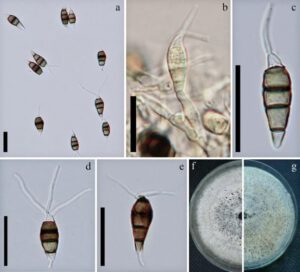Pestalotiopsis umbrinospora Maharachch. & K.D. Hyde [as 'umberspora'], in Maharachchikumbura, Guo, Cai, Chukeatirote, Wu, Sun, Crous, Bhat, McKenzie, Bahkali & Hyde, Fungal Diversity 56(1): 121 (2012)
Index Fungorum number: IF 569202; Facesoffungi number: FoF 00016
Etymology – The specific epithet is based on the Latin = umber, in reference to the umber earth brown colour of the median cells of the conidia.
Conidiophores reduced to conidiogenous cells. Conidiogenous cells discrete or integrated, lageniform, hyaline, smooth-walled, and sometimes septate. Conidia 19–25 × 6–8 μm (x̄
Culture characters – Colonies on PDA reaching 7 cm diam. after 6 days at 25 °C, edge entire, whitish, aerial mycelium on the surface, fruiting bodies black, gregarious; reverse of culture pale yellow.
Habitat/Distribution – Saprobe on dead plant material, Guangxi Province, China.
Material examined – China, Guangxi Province, Shiwandashan, on dead leaves of unidentified plant, 30 December 1997, Wenping Wu WU1554j (HMAS042986, holotype; MFLU12-0421, isotype; ex-type living culture NN042986 = MFLUCC 12-0285).
Notes – Pestalotiopsis umberspora is a phylogenetically distinct species in the genus and separates well in tef1 and combined multi-locus tree with its phylogenetically related species P. crysea. Its umber-coloured and relatively wider mature conidia are characteristic of the species.

Figure 1. a. Pestalotiopsis umbrinospora (holotype). b. Conidiophores/ conidiogenous cells. c–e. Conidia. f. g. Colony on PDA, f. from above, g. from below. Scale Bars: a–e = 20 μm
